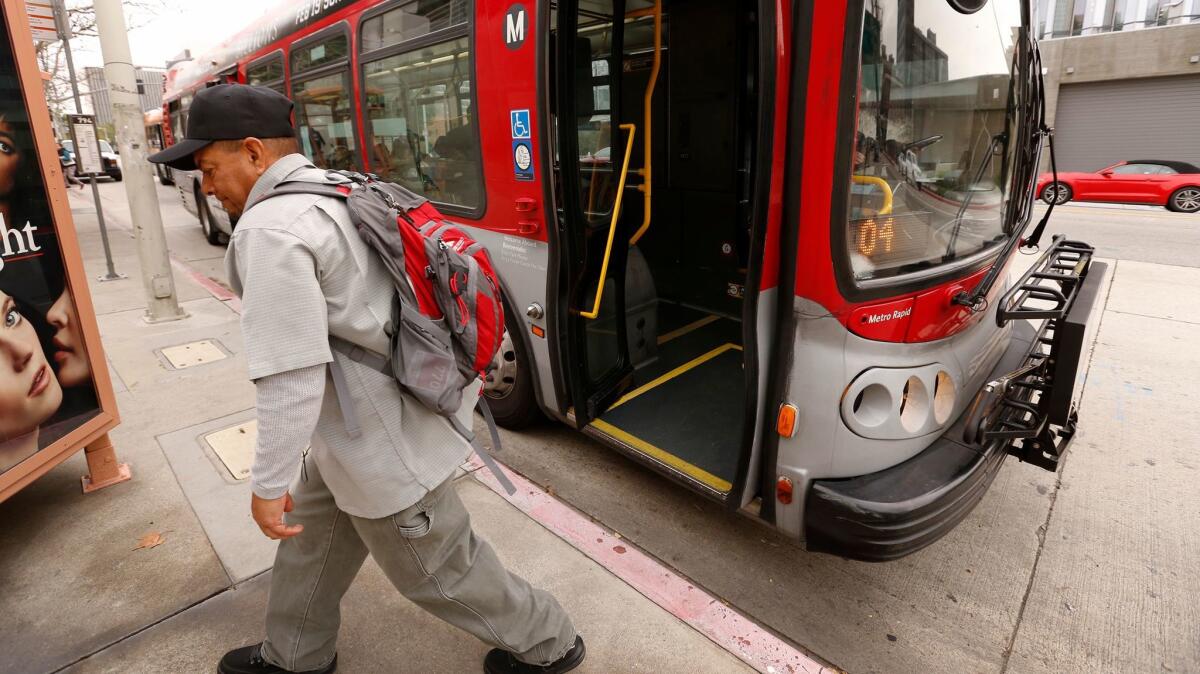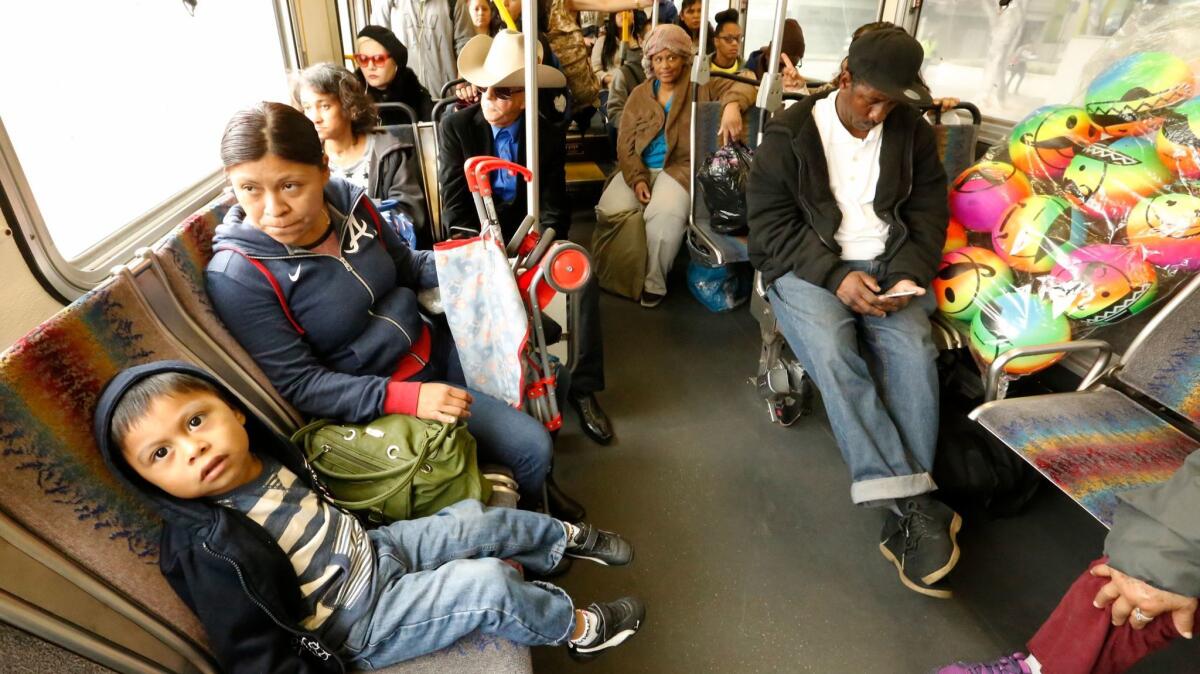The Metro can take you farther than ever. Here’s why ridership dropped — again

Trips taken on the L.A. County Metropolitan Transportation Authority’s bus and rail system dropped in 2016 by nearly 6%, driven by a continuing slide in bus ridership. (Al Seib / Los Angeles Times)
- Share via
Last spring, transportation officials opened two light-rail extensions to Azusa and Santa Monica, connecting the eastern and western reaches of Los Angeles County to the passenger rail system for the first time in decades.
Six months later, 71.5% of voters approved Measure M, a sales tax increase to expand the transit network again.
It was a red-letter year for public transportation with one exception: Ridership.
Trips taken on the Metropolitan Transportation Authority’s sprawling bus and rail system dropped again in 2016, by nearly 6%, driven by a continuing slide in bus ridership, according to agency data.
Subway and light-rail boardings rose 4.4%, bolstered by the debut of the Gold Line and Expo Line extensions. But those gains did not cancel out a decline in annual bus ridership, which fell 8.9% to 304 million — the lowest in more than a decade.
Although year-to-year ridership changes are worth noting, the bigger issue is how Metro has fared over time, said Michael Manville, a professor of urban planning at UCLA’s Luskin School of Public Affairs.
Since 2009, Metro has opened four new rail extensions at a cost of more than $4 billion. In the same period, rail ridership soared 21%, but bus trips — a much larger share of overall ridership — dropped 18%.
“We’ve made a lot of investments, and we’re going forward to make a lot more investments,” Manville said. “And at best, ridership hasn’t grown.”
Where bus riders have gone, and how to win them back, are questions that are vexing Metro officials as they lay the groundwork for the most ambitious rail expansion in L.A.’s modern history.
Even if the rail network doubles in size, experts say, ample bus service will still be an essential cog in the transit system to shuttle passengers to and from train stations, to add capacity along major corridors, and to serve neighborhoods where rail won’t be built.
Metro Chief Executive Phil Washington has said he hopes to convert 20% to 25% of commuters in the county into transit users. Right now, that number is closer to 7%, and it is lower in surrounding counties.

Officials say they’re studying why riders have left the system, and how to bring them back. They add that L.A.’s bus woes are in line with other major cities that have shed passengers, including New York and Washington, D.C.
Some experts, including Manville, say Metro may have lost a small group of dedicated riders, who formerly took transit for commuting, running errands and other trips. Because those passengers take multiple trips per day, they have an outsize impact on overall ridership.
“If we lose our core, bread-and-butter riders who use the system for every purpose, then that’s going to have a bigger impact on us than losing someone who takes transit to Dodgers games,” said Conan Cheung, Metro’s executive officer for finance.
It’s possible that some Metro buses just don’t take people where they need to go anymore or the trips just take too long, he added.
Some riders have found, after moving or getting a new job, that their once-simple transit commute now requires transferring multiple times.
We’ve made a lot of investments, and we’re going forward to make a lot more investments. And at best, ridership hasn’t grown.
— Michael Manville, UCLA urban planning professor

“Customers are saying that their travel patterns have changed, but we haven’t changed to reflect that,” Cheung said.
In many major cities, commuters converge on a city center in the morning, then flow outward again at the end of the workday. In Los Angeles, Metro tries to serve an estimated 26 commercial hubs scattered across the region, from downtown to the Westside and the South Bay, by providing a grid of bus and rail lines.
But tweaks over the years to routes and schedules may have eroded the efficiency of some workhorse bus lines that serve major corridors, or made the routes more confusing for riders. It has been more than a decade since Metro has examined and overhauled the bus network, Cheung said.
As L.A.’s economy has steadily improved, traffic has grown worse, and so has Metro’s on-time performance. Agency figures show that about 76% of buses arrived on time in the 2014 fiscal year. This year, the number is near 72%.
“We’re stuck in traffic,” Cheung said. “It makes bus service less attractive than other alternatives.”
Those include driving and hailing an Uber or Lyft car, but also alternatives that Metro has publicly supported, including walking and biking.
As she boarded a Line 81 bus in downtown, Jessica McLane, 25, said she has taken transit since she was a child. McLane doesn’t like the stress of driving, but after one too many times being late to work on the bus, she decided to start saving for a car.
For now, she’s putting away small amounts each month, and catching rides with friends when she can.
“I don’t want anything fancy,” McLane said, as the bus rumbled toward USC. “Just something a little more reliable.”
Officials say security also is a concern. In a recent survey, nearly three in 10 former passengers told Metro they stopped riding because they felt unsafe.
Metro has recently doubled its fleet of private security guards and has urged the agency’s directors to hire other law enforcement agencies to patrol parts of the system traditionally overseen by the Los Angeles County Sheriff’s Department.
“What we consistently hear is that security issues and customer conduct are the main reasons folks have left our system,” Metro spokeswoman Pauletta Tonilas said.
Recent changes to policies that affect immigrants — one of Metro’s most loyal customer bases — play a role too, she said.
Census data show that many immigrants ride the bus or train when they first arrive in Los Angeles. But the longer they live in the area, the less likely they are to keep riding, either because they gain access to a car or move to a suburb with fewer transit options.
Immigration rates to Southern California also have slowed since a peak in the 1980s, reducing the number of new immigrants who rely on Metro, Cheung said.
Other riders may have taken advantage of a new law in 2015 that allowed undocumented immigrants to apply for California driver’s licenses. In its first year, more than 600,000 people received licenses.
Metro officials add that some ridership declines are a sign that new investments in the system are working as they should.
The system’s most-traveled bus route, which connects East Los Angeles and Santa Monica, saw a 13% decline in ridership from 2015 to 2016. But some of those riders on the 720 Rapid may have transferred to the Expo Line, which runs along a roughly parallel route a few miles to the south.
“To a certain extent, the rail lines cannibalize the bus,” Manville said. “If you happen to live near a rail line that opens up, and the rail line is faster and more comfortable, then you move over.”
The Expo Line saw a 15.5% increase in trips in 2016, driven by the $1.5-billion extension to Santa Monica that opened in May.
Twitter: @laura_nelson
ALSO
New survey of consumer confidence in Los Angeles fell in fourth quarter
‘This is the worst I have seen’: California’s roads are in dire shape, says former Caltrans director
U.S. Transportation department executive approved grant days before taking job with rail contractor
More to Read
Sign up for Essential California
The most important California stories and recommendations in your inbox every morning.
You may occasionally receive promotional content from the Los Angeles Times.











